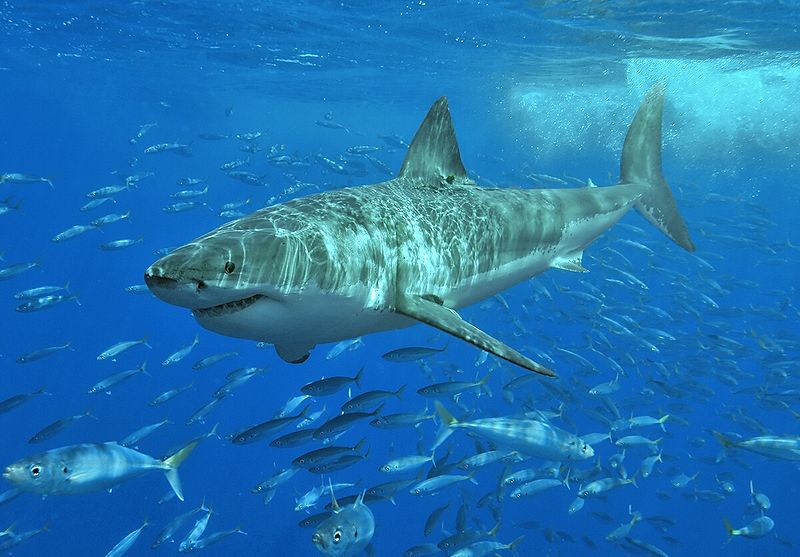
The phylum Chordata, which the Great white falls into, also includes reptiles, birds, fishes, and amphibians. All together these invertebrates compromise 45,000 living species of Chordates. Some charecteristics of this class are a dorsal, holow nerve cord, a notochord some time during development, gill slits during development, and a muscular post-anal tail.
Common Name: Great White Shark
Scientific Name: Carcharodon Carcharias
Phylum: Chordata
Family: Lamnidae
Genus: Carchardon,
Species: Carcharias
Hawaiian Name: Niuhi
Description: The Great white is one of the largest sharks in its class. It has a torpedo-shaped body, a pointed snout, a crescent-shaped tail, 5 gill slits, no fin spines, an anal fin, and 3 main fins: the dorsal fin, located on its back, and 2 pectoral fins , which are on its sides.The only part of the Great white that is actually white is its underbelly. Its top surface can be gray to blue gray. These colors contribute to its hunting because the great white usually strikes from below so its grayish color helps the shark to blend in with the dark water making it unoticed to its prey.
Size: 12-16 feet long. Biggest great white ever recorded was 23 feet long, weighing about 7,000 pounds. Females are usually larger than males.
Habitats: Hawaii, South America, South Africa, coastlines of Alaska and California, Australia, New Zealand, Mediterranean Sea, West Africa to Scandinavia, Japan, and the eastern coastline of China and southern Russia.
Diet: Young great white sharks eat fish, rays, and other sharks. Adults eat larger prey, including sea lions and seals, small toothed whales, such as belugas, otters, and sea turtles.
Physiological Features: They have the ability to warm their body temperature, brain, eyes, muscles, and stomach above ambient sea water. This is called regional endothermy. This way , little heat is lost to the outside water and the heat is kept inside the animales body.
There is some evidence that the great white has a high metabolism. Reaserchers found out that the blood of the great white conatins high values of hemoglobin, which is the substance found in the red blood cells that carries oxygen.
The reason this supports high metabolism is that it means more oxygen can be carried in the great whites blood at any given time, the more oxygen, the more aerobic metabolism, which is the requirment of oxygen or air for life.
Reproductive Cycle:Great whites display ophagy, which is the form of reproduction when the embryos eat and are nourished by a supply of unfertilised eggs, which the female continues to ovulate during pregnancy.
The gestation period is unknown, but may be approximately 18 months with females breeding only once every 2–3 years. Although limited information is available on the reproductive cycle of a female, it is suggested that the birth period heppens between December and June.
